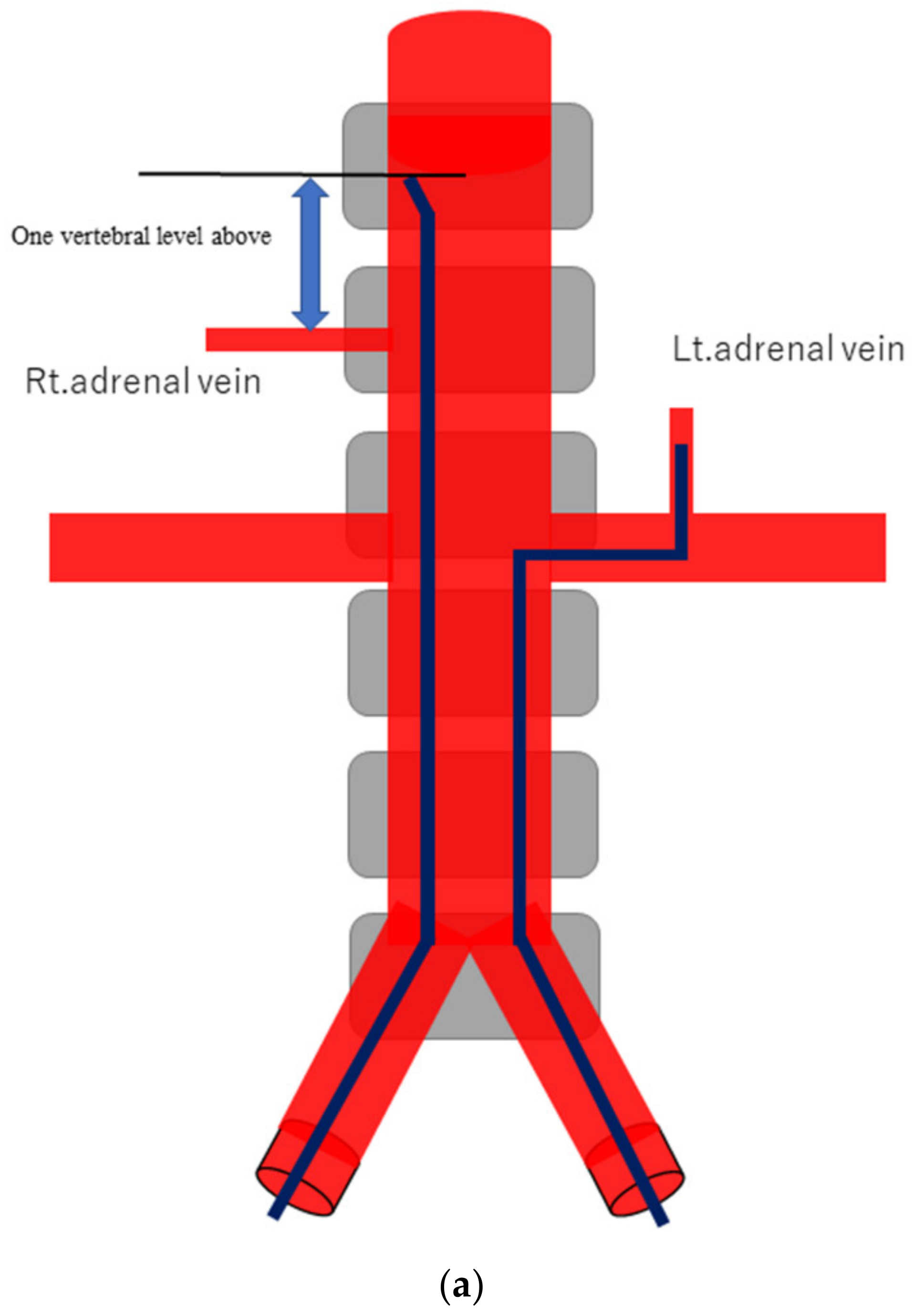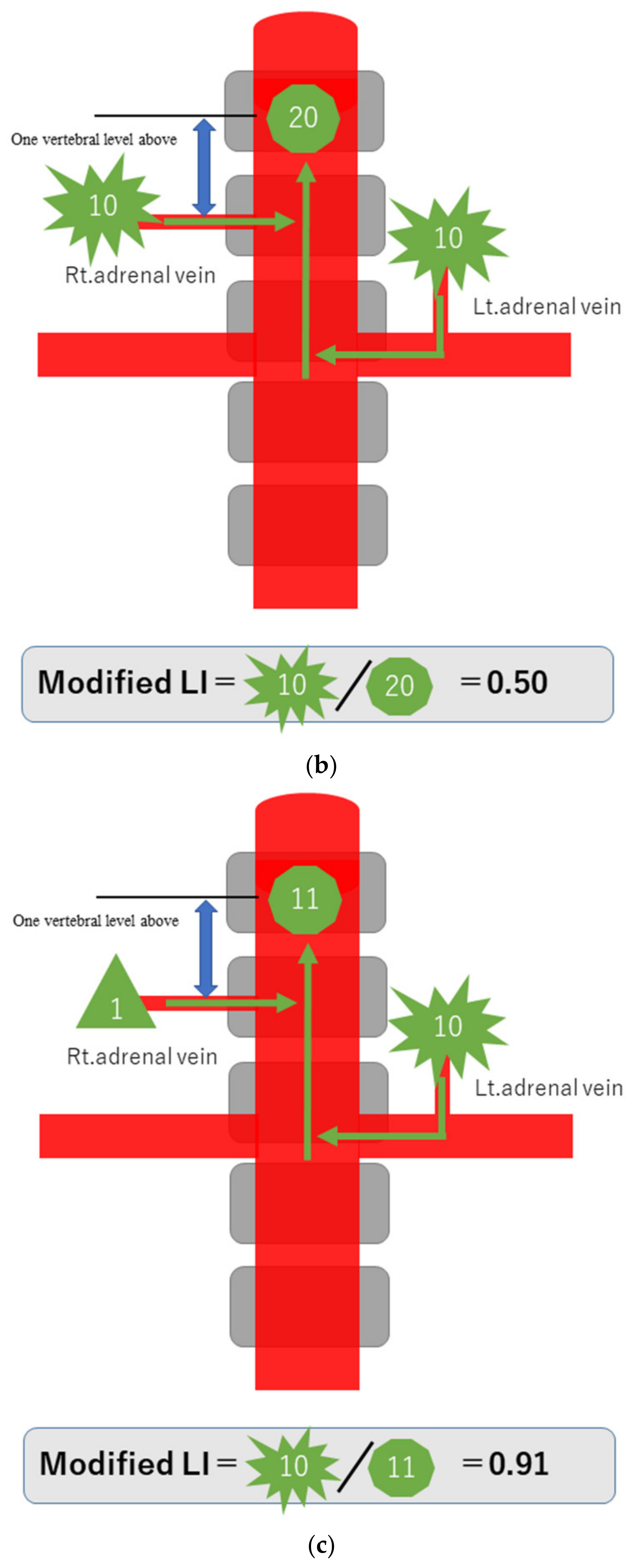An Ancillary Method for Adrenal Venous Sampling in Cases in Which Right Adrenal Vein Sampling Is Difficult
Abstract
1. Introduction
2. Materials and Methods
2.1. Patient Population
2.2. AVS Procedure
3. Data Analysis
3.1. Principle of Local Diagnosis of PA by the Modified LI
3.2. Statistical Analysis
4. Results
5. Discussion
Author Contributions
Funding
Institutional Review Board Statement
Informed Consent Statement
Data Availability Statement
Conflicts of Interest
References
- Funder, J.W.; Carey, R.M.; Fardella, C.; Gomez-Sanchez, C.E.; Mantero, F.; Stowasser, M.; Young Jr, W.F.; Montori, V.M. Case detection, diagnosis, and treatment of patients with primary aldosteronism: An endocrine society clinical practice guideline. J. Clin. Endocrinol. Metab. 2008, 93, 3266–3281. [Google Scholar] [CrossRef] [PubMed]
- Calhoun, D.A.; Kaplan, N.M. Is There an Unrecognized Epidemic of Primary Aldosteronism? (Pro). Hypertension 2007, 50, 447–453. [Google Scholar] [CrossRef]
- Rossi, G.P.; Auchus, R.J.; Brown, M.; Lenders, J.W.; Naruse, M.; Plouin, P.F.; Satoh, F.; Young, W.F. An Expert Consensus Statement on Use of Adrenal Vein Sampling for the Subtyping of Primary Aldosteronism. Hypertension 2014, 63, 151–160. [Google Scholar] [CrossRef] [PubMed]
- Rossi, G.P.; Cesari, M.; Cuspidi, C.; Maiolino, G.; Cicala, M.V.; Bisogni, V.; Mantero, F.; Pessina, A.C. Long-term control of arterial hypertension and regression of left ventricular hypertrophy with treatment of primary aldosteronism. Hypertension 2013, 62, 62–69. [Google Scholar] [CrossRef] [PubMed]
- Reincke, M.; Fischer, E.; Gerum, S.; Merkle, K.; Schulz, S.; Pallauf, A.; Quinkler, M.; Hanslik, G.; Lang, K.; Hahner, S.; et al. Observational study mortality in treated primary aldosteronism: The German Conn’s registry. Hypertension 2012, 60, 618–624. [Google Scholar] [CrossRef]
- Kempers, M.J.; Lenders, J.W.; Van Outheusden, L.; van der Wilt, G.J.; Kool, L.J.S.; Hermus, A.R.; Deinum, J. Systematic Review: Diagnostic Procedures to Differentiate Unilateral from Bilateral Adrenal Abnormality in Primary Aldosteronism. Ann. Intern. Med. 2009, 151, 329–337. [Google Scholar] [CrossRef]
- Powlson, A.S.; Gurnell, M.; Brown, M.J. Nuclear imaging in the diagnosis of primary aldosteronism. Curr. Opin. Endocrinol. Diabetes Obes. 2015, 22, 150–156. [Google Scholar] [CrossRef]
- Cardenas, S.M.C.; Santhanam, P. 11C-metomidate PET in the diagnosis of adrenal masses and primary aldosteronism: A review of the literature. Endocrine 2020, 70, 479–487. [Google Scholar] [CrossRef]
- Nishikawa, T.; Omura, M.; Satoh, F.; Shibata, H.; Takahashi, K.; Tamura, N.; Tanabe, A. Guidelines for the diagnosis and treatment of primary aldosteronism—The Japan Endocrine Society 2009. Endocr. J. 2011, 58, 711–721. [Google Scholar] [CrossRef]
- Daunt, N. Adrenal Vein Sampling: How to Make It Quick, Easy, and Successful. Radiographics 2005, 25, S143–S158. [Google Scholar] [CrossRef]
- Auchus, R.J.; Michaelis, C.; Wians, F.H., Jr.; Dolmatch, B.L.; Josephs, S.C.; Trimmer, C.K.; Anderson, M.E.; Nwariaku, F.E. Rapid Cortisol Assays Improve the Success Rate of Adrenal Vein Sampling for Primary Aldosteronism. Ann. Surg. 2009, 249, 318–321. [Google Scholar] [CrossRef]
- Matsuura, T.; Takase, K.; Ota, H.; Yamada, T.; Sato, A.; Satoh, F.; Takahashi, S. Radiologic Anatomy of the Right Adrenal Vein: Preliminary Experience with MDCT. Am. J. Roentgenol. 2008, 191, 402–408. [Google Scholar] [CrossRef]
- Kahn, S.L.; Angle, J.F. Adrenal vein sampling. Tech. Vasc. Interv. Radiol. 2010, 13, 110–125. [Google Scholar] [CrossRef]
- Rossi, G.P.; Barisa, M.; Allolio, B.; Auchus, R.J.; Amar, L.; Cohen, D.; Degenhart, C.; Deinum, J.; Fischer, E.; Gordon, R.; et al. The Adrenal Vein Sampling International Study (AVIS) for Identifying the Major Subtypes of Primary Aldosteronism. J. Clin. Endocrinol. Metab. 2012, 97, 1606–1614. [Google Scholar] [CrossRef]
- Young, W.F., Jr.; Klee, G.G. Primary aldosteronism. Diagnostic evaluation. Endocrinol. Metab. Clin. N. Am. 1988, 17, 367–395. [Google Scholar] [CrossRef]
- Rossitto, G.; Amar, L.; Azizi, M.; Riester, A.; Reincke, M.; Degenhart, C.; Widimsky, J.; Naruse, M.; Deinum, J.; Schultzekool, L.; et al. Subtyping of Primary Aldosteronism in the AVIS-2 Study: Assessment of Selectivity and Lateralization. J. Clin. Endocrinol. Metab. 2020, 105, 2042–2052. [Google Scholar] [CrossRef]
- Onozawa, S.; Murata, S.; Yamaguchi, H.; Mine, T.; Yasui, D.; Sugihara, H.; Tajima, H. Can an enhanced thin-slice computed tomography delineate the right adrenal vein and improve the success rate? Jpn. J. Radiol. 2016, 34, 611–619. [Google Scholar] [CrossRef]
- Satoh, F.; Abe, T.; Tanemoto, M.; Nakamura, M.; Abe, M.; Uruno, A.; Morimoto, R.; Sato, A.; Takase, K.; Ishidoya, S.; et al. Localization of aldosterone-producing adrenocortical adenomas: Significance of ad-renal venous sampling. Hypertens. Res. 2007, 30, 1083–1095. [Google Scholar] [CrossRef]
- Young, W.F., Jr.; Stanson, A.W.; Thompson, G.B.; Grant, C.S.; Farley, D.R.; van Heerden, J.A. Role for adrenal venous sampling in primary aldosteronism. Surgery 2004, 136, 1227–1235. [Google Scholar] [CrossRef]
- Ceral, J.; Solar, M.; Krajina, A.; Ballon, M.; Suba, P.; Cap, J. Adrenal venous sampling in primary aldosteronism: A low dilution of adrenal venous blood is crucial for a correct interpretation of the results. Eur. J. Endocrinol. 2010, 162, 101–107. [Google Scholar] [CrossRef]
- Lee, B.C.; Chang, C.C.; TAIPAI Study Group. Regarding “Diagnostic utility of data from adrenal venous sampling for primary aldosteronism despite failed cannulation of the right adrenal vein”. Surgery 2016, 159, 1478–1479. [Google Scholar] [CrossRef]
- Pasternak, J.D.; Epelboym, I.; Seiser, N.; Wingo, M.; Herman, M.; Cowan, V.; Gosnell, J.E.; Shen, W.T.; Kerlan, R.K., Jr.; Lee, J.A.; et al. Diagnostic utility of data from adrenal venous sampling for primary aldosteronism despite failed cannulation of the right adrenal vein. Surgery 2016, 159, 267–274. [Google Scholar] [CrossRef]
- Fujii, Y.; Umakoshi, H.; Wada, N.; Ichijo, T.; Kamemura, K.; Matsuda, Y.; Kai, T.; Fukuoka, T.; Sakamoto, R.; Ogo, A.; et al. Subtype prediction of primary aldosteronism by combining aldosterone concentrations in the left adrenal vein and inferior vena cava: A multicenter collaborative study on adrenal venous sampling. J. Hum. Hypertens. 2017, 32, 12–19. [Google Scholar] [CrossRef]
- Morita, S.; Yamazaki, H.; Sonoyama, Y.; Nishina, Y.; Ichihara, A.; Sakai, S. Successful Adrenal Venous Sampling by Non-experts with Reference to CT Images. Cardiovasc. Interv. Radiol. 2016, 39, 1001–1006. [Google Scholar] [CrossRef]








| Characteristics | |
|---|---|
| Age (year) | Mean: 56 (range: 28–73) |
| SEX | |
| Male | 21 |
| Female | 23 |
| Blood pressure(mmHg) | |
| Systolic | Mean: 150 (range: 222–110) |
| Diastolic | 91 (130–52) |
| Antihypertensive drugs at first visit | 44/44 |
| PAC (pg/mL) (Mean ± SD) | 253.3 ± 255.0 |
| PRA (ng/mL/hr) (Mean ± SD) | 0.3 ± 0.2 |
| ARR (Mean ± SD) | 992.3 ± 977.0 |
| Adrenal lesion on CT | |
| No | 14 |
| Yes | 30 |
| Right | 9 |
| Left | 17 |
| Bilateral | 4 |
| UAPA (n = 20) | IHA (n = 24) | ||
|---|---|---|---|
| Right (n = 8) | Left (n = 12) | ||
| ARR | |||
| Pre-operation (Mean ± SD) | 1429.9 ± 902.6 | 1562.1 ± 1429.9 | 560.6 ± 356.8 |
| Post-operation (Mean ± SD) | 90.7 ± 55.0 | 89.6 ± 44.0 | N/A |
| Adrenal lesion on CT | |||
| No | 1 | 0 | 13 |
| Yes | 7 | 12 | 11 |
| Right | 7 | 0 | 2 |
| Left | 0 | 10 | 7 |
| Bilateral | 0 | 2 | 2 |
| Conventional LI (Mean ± SD) | 23.26 ± 25.76 | 7.05 ± 5.33 | 1.56 ± 1.32 |
| Modified LI (Mean ± SD) | 0.37 ± 0.38 | 3.46 ± 1.97 | 1.52 ± 1.11 |
| AUC | Threshold | Sensitivity | Specificity | ||
|---|---|---|---|---|---|
| Conventional LI | UAPA | 0.90 | 1.9 | 95% | 83% |
| Modified LI | Rt.APA | 0.92 | 0.7 | 87% | 94% |
| Lt.APA | 0.81 | 2.2 | 75% | 94% |
Disclaimer/Publisher’s Note: The statements, opinions and data contained in all publications are solely those of the individual author(s) and contributor(s) and not of MDPI and/or the editor(s). MDPI and/or the editor(s) disclaim responsibility for any injury to people or property resulting from any ideas, methods, instructions or products referred to in the content. |
© 2023 by the authors. Licensee MDPI, Basel, Switzerland. This article is an open access article distributed under the terms and conditions of the Creative Commons Attribution (CC BY) license (https://creativecommons.org/licenses/by/4.0/).
Share and Cite
Yamamoto, A.; Fukunaga, T.; Takeuchi, M.; Nakamura, H.; Kanki, A.; Higaki, A.; Tamada, T. An Ancillary Method for Adrenal Venous Sampling in Cases in Which Right Adrenal Vein Sampling Is Difficult. Diagnostics 2023, 13, 649. https://doi.org/10.3390/diagnostics13040649
Yamamoto A, Fukunaga T, Takeuchi M, Nakamura H, Kanki A, Higaki A, Tamada T. An Ancillary Method for Adrenal Venous Sampling in Cases in Which Right Adrenal Vein Sampling Is Difficult. Diagnostics. 2023; 13(4):649. https://doi.org/10.3390/diagnostics13040649
Chicago/Turabian StyleYamamoto, Akira, Takeshi Fukunaga, Mitsuru Takeuchi, Hiroki Nakamura, Akihiko Kanki, Atsushi Higaki, and Tsutomu Tamada. 2023. "An Ancillary Method for Adrenal Venous Sampling in Cases in Which Right Adrenal Vein Sampling Is Difficult" Diagnostics 13, no. 4: 649. https://doi.org/10.3390/diagnostics13040649
APA StyleYamamoto, A., Fukunaga, T., Takeuchi, M., Nakamura, H., Kanki, A., Higaki, A., & Tamada, T. (2023). An Ancillary Method for Adrenal Venous Sampling in Cases in Which Right Adrenal Vein Sampling Is Difficult. Diagnostics, 13(4), 649. https://doi.org/10.3390/diagnostics13040649






